Death is an Outrage
While you were reading this sentence, a dozen people just died, worldwide. There. Another dozen people have perished. I think this is an outrage. I want to tell you why I think so, and what nanomedicine can do to help. This article is taken from a lecture delivered by the author at the Fifth Alcor Conference on Extreme Life Extension, 16 November 2002, Newport Beach, CA. More extensive original lecture materials are also available online at the author's web site.Copyright © Robert A. Freitas Jr.
While you were reading this sentence, a dozen people just died, worldwide.
There. Another dozen people have perished. I think this is an outrage. I want to tell you why I think so, and what nanomedicine can do to help.

Let's look at the dimensions of the human holocaust that we call "natural death." The death toll in the Year 2001 was worst in India. Almost 9 million casualties. The bodies were piled nearly as high in China. The United States fell in third, with 2.4 million fatalities. 21 nations lost over half a million lives, each. These 21 countries represented all cultures, races, creeds, and continents. The human death toll in the Year 2001 from all 227 nations on Earth was nearly 55 million people, of which about 52 million were not directly caused by human action, that is, not accidents, or suicides, or war. They were "natural" deaths.

Even the most widely recognized greatest disasters in human history pale in comparison to natural death. For example, the typhoon that struck Bangladesh in 1970 washed away a million lives. In 1232 AD, Genghis Khan burned the Persian city of Herat to the ground. It took his Mongol horde an entire week to slaughter the 1.6 million inhabitants. The Plague took 15 million per year, World War II, 9 million per year, for half a decade each. The worldwide influenza pandemic of 1918 exterminated less than 22 million people - not even half the annual casualties from natural death. But natural death took 52 million lives last year. We can only conclude that natural death is measurably the greatest catastrophe humankind has ever faced.
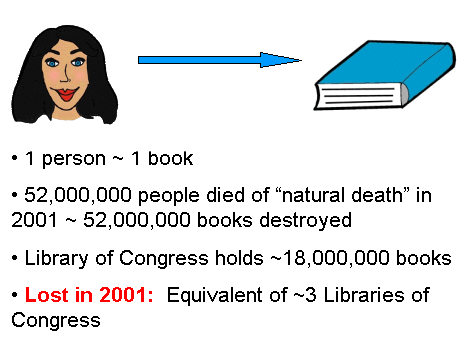
Of course we're outraged by natural death because of the obvious personal consequences. But the cost to humanity of our individual deaths is rarely appreciated, truly staggering, and equally heartbreaking. Each one of us carries within us a complex universe of knowledge, life experience, and human relationships. Each individual is gifted with unique insights possessed by no one else. Almost all of this rich treasury of information is forever lost to mankind when we die. This lost treasury is truly enormous. If the vast content of each person's life can be summarized in just one book, then every year, natural death robs us of 52 million books, worldwide. But the U.S. Library of Congress, the world's largest collection of physical books, holds only 18 million volumes. So each year, we allow a destruction of knowledge equivalent to three Libraries of Congress.
It is as if in 2001, somebody burned the Library of Congress to the ground. Once in January. Then again in May. Then again in September. 52 million books go up in flames. And then in 2002, they burn it down again. Three more times. And then again in 2003. What's even worse is that if you agree with me that the sum total of each human mind would really fill many, many books, and not just one, then you must accept that the devastation of knowledge is actually far greater than I've suggested here.
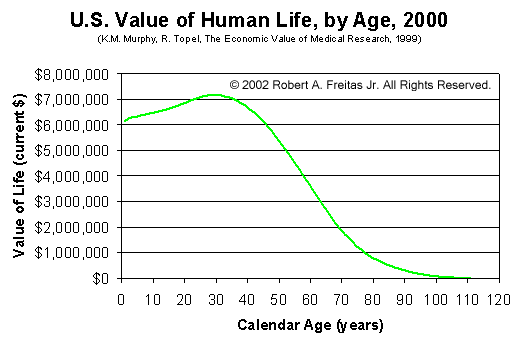
Besides this staggering sacrifice of information, natural death also destroys wealth on a grand scale. According to the Lasker Foundation, a dozen or so studies since the mid-1970s have found the value for human life is in the range of $3 to $7 million dollars, using many different methodologies. More recently, Murphy and Topel at the University of Chicago drew this chart (which I've updated to Year-2000 dollars) showing the value of human life at every age. It recognizes that fewer years remain to us at older ages. But this is only half of the equation.
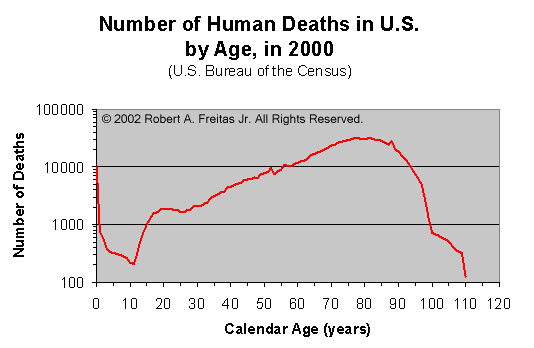
This chart shows estimates from the Census Bureau of the number of people that died in the United States in the Year 2000, in each age cohort, year by year. If you multiply the death rate at each age, from this chart, by the dollar value at each age, from the previous chart, you get the economic loss at each calendar age, due to natural death. The sum of these economic losses divided by the total number of deaths gives you the average economic value of a human life lost.
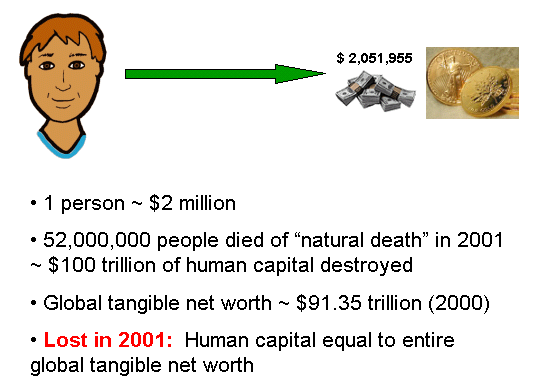
The result is an average value of about $2 million dollars for each human life lost. If we conservatively assume that the population age structure and the age-specific mortality is the same worldwide as in the United States, then the worldwide natural death toll of 52 million people in the Year 2001 represents an economic loss of about $100 trillion dollars. Every year.
How big of an economic calamity is this? Taking Federal Reserve figures for the total tangible wealth of the United States, including all financial assets, all real estate, and all consumer durables, net of debt, and applying the ratio of U.S. to world GDP gives us an estimate of total global tangible net worth of $91 trillion dollars. So this means that every year, natural death robs us of human capital equivalent in value to the entire tangible wealth of the world.
It is as if in the Year 2001, someone took out a giant broom and swept up all the physical assets of human civilization into a cosmic trash can, and then threw it all away. That's $100 trillion dollars of financial assets, real estate, and durable goods. Gone. And then in 2002, the giant broom sweeps again. Another $100 trillion dollars of human capital is destroyed, or three times larger than the $33 trillion dollars of annual economic activity represented by world GDP. Then it happens again in 2003.
But the economic disaster caused by natural death is even worse, if you go back through history. Since the modern human species first emerged, perhaps 25 millennia ago, 34 billion people have ever walked the Earth, and 28 billion of us have already died. The equivalent total information waste is more than 28 billion books, enough to fill almost 2000 Libraries of Congress. The equivalent total economic waste is about $60 thousand trillion dollars, enough to rebuild our current tangible civilization 600 times over. If you carry the tally back a million years, to the very dawn of man, all these figures about double. Natural death is a disaster of unprecedented proportions in human history.
So ... what's being done about this? Let's take a statistical look at the progress to date.
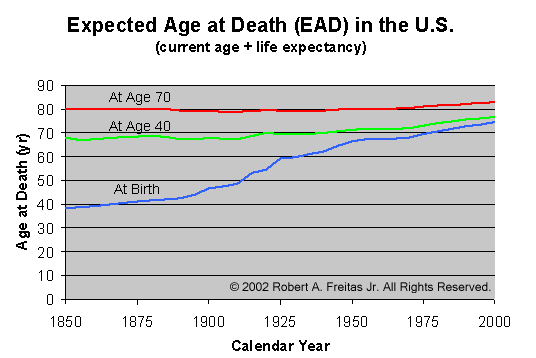
This chart, compiled from Census Bureau data, shows that for the last one-and-a-half centuries, life expectancy at birth has risen dramatically in the United States. A newborn child in the Year 1850 could only expect to live to 38 years, but should reach almost 75 years today. To measure longevity, I'm using the Expected Age at Death, which is just your current age plus your remaining life expectancy.
But 20th century medical technology has mainly improved the longevity of the very young. Since 1850, the Expected Age at Death of a 40-year-old has only improved from 68 years to 77 years. The Expected Age at Death of a 70-year-old has only improved from 80 years to 83 years. In other words, a 70-year-old's chances of living another 10 years were about as good in 1850 as they are today. Not much progress. But let's take a closer look at the data.
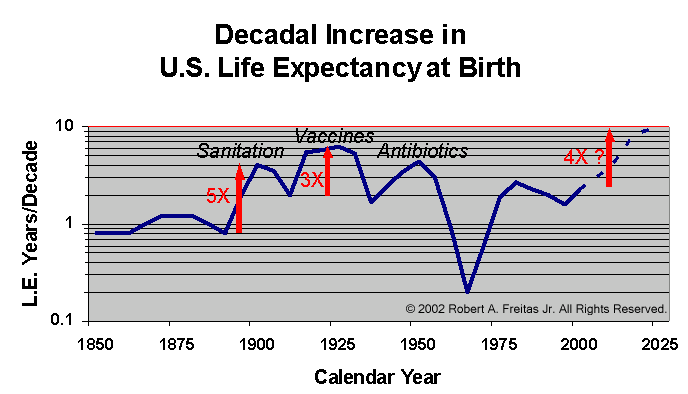
This chart shows the rate of Change in Life Expectancy at birth since 1850, as measured in years of extra life expectancy achieved by medical technology per decade of calendar time. If we could get to a rate of 10 years of life extension per decade, then medical technology would be extending life exactly as fast as we're aging, postponing natural death, on average, indefinitely. We see from the chart that the Change in Life Expectancy improved at only 1 year per decade up until 1890.
After 1890, the Change in Life Expectancy of newborns jumped dramatically, reaching more than 6 years per decade at its peak in 1925. This was due to the rapid introduction of several basic medical breakthroughs, like public sanitation, comprehensive vaccination programs, and later, antibiotics.
Note that the rate of Change jumped from 0.8 to 4 years per decade during 1890 to 1900, a fivefold increase in a 10 year calendar span. The rate soared from 2 to 6 years per decade during 1910 to 1925, a threefold increase in a 15 year calendar span. So we know it's possible to see very rapid increases in the rate of Change in Life Expectancy, when new technology is brought to bear on the problem. In other words, history tells us that the current 2.3 year per decade rate of progress could plausibly quadruple to the "magic" 10 years per decade threshold, in the space of just 10-20 years from today, if new resources and new medical technologies are focused on improving longevity.
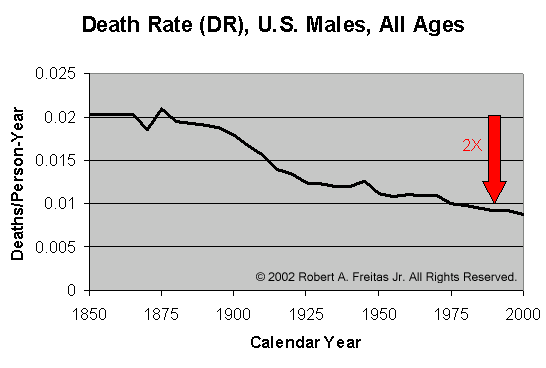
Worried parents and life insurance salesmen often complain that the young think they're immortal. Well, in a sense, the young are almost right! There are age groups for which it can validly be said that extreme life extension has already been achieved, using existing medical technology. To better appreciate this accomplishment, we need to talk about death rates for a few minutes.
The chart shows the aggregate death rate for all males, at all ages, in the United States, from 1850 to 2000. In 1850, each male had a 2 percent chance of dying in the next year. By 2000, each male had a 1 percent chance of dying in the next year. So over this 150-year time span, the death rate was cut in half. As a result,...
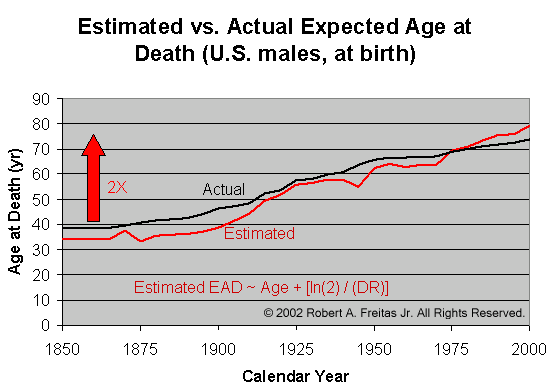
...the life expectancy from birth has approximately doubled, from 38 years in 1850 to almost 75 years in 2000, as shown by the black curve.
A very simple formula, written in red below, can be devised for estimating the Expected Age at Death. This formula encodes the simple truth that, roughly speaking, cutting the death rate in half doubles the life expectancy, as measured from the current age of the individual. The formula assumes a single net death rate, for a whole population of mixed ages. This is an important point, because the natural death rate in humans depends on our physiological age. Death rates typically rise with advancing age, except at the oldest ages.
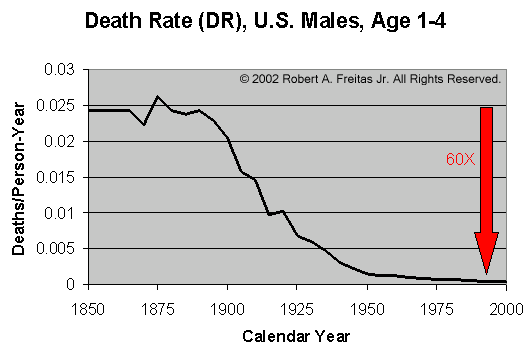
Medical technology has had its greatest impact to date in preventing infant mortality, especially between the ages of 1 to 4. In the Year 1850, a young child in this age cohort had a 2.4 percent probability of dying in the next year. Today, the probability of dying in the next year for these children has been reduced from 2.4 percent to 0.04 percent. That's a phenomenal 60-fold reduction.
What if future medical technologies permit us first to arrest, and later to reverse, the biological effects of aging? In such an era, our bodies would no longer tumble down a staircase of degeneration and frailty. Instead, our statistical death rate would take on some approximately fixed value that's appropriate for our physiological-age cohort, not our calendar-age cohort. Biological age would no longer march in lockstep with calendar age. So, how much longer might we live, if we could just keep the bodies we had when we were young?
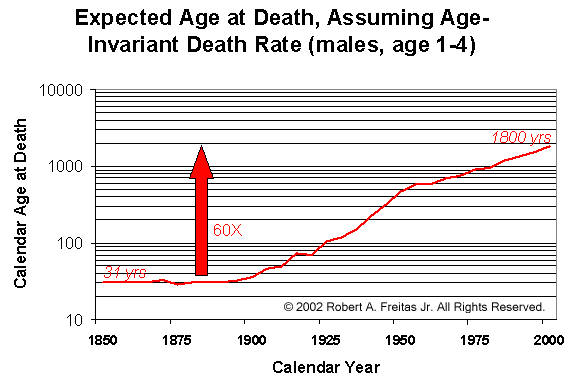
Well, in the Year 1850, the death rate for a U.S. male between the ages of 1 and 4 implied an Expected Age at Death, according to our formula, of only 31 years. That is, in 1850, a child that could remain perpetually 1-4 years old physiologically, would have died, on average, after 31 calendar years. Early childhood was still very unhealthy and dangerous in those days.
As medical technology slowly improved, childhood became far less dangerous. Most of the specific medical causes of early childhood death have now been analyzed, and conquered. As a result, a child that could remain perpetually 1-4 years old biologically today would not die, on average, until he or she reached the calendar age of 1800 years. Death would usually come from some form of non-medical accident, which is the leading cause of death up to age 44.
Of course, most of us aren't 1-4 years old. How long would we live if we could halt any further biological aging of our bodies right now, at our current age?
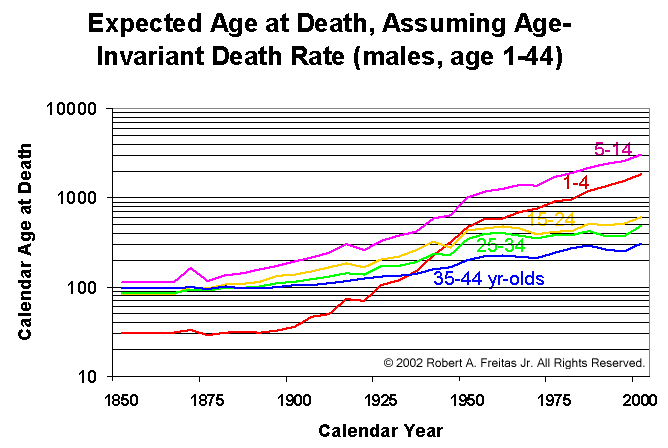
Here's the answer for various biological age cohorts up to 44 years old.
The 10-year-olds among us would fare the best, reaching an average Expected Age at Death exceeding 3000 calendar years. The 20-year-olds would make it to 600 calendar years. Life has even become less dangerous for the 40-year-olds, who could survive to an average calendar age of 300 years in today's medical environment, if further biological aging could be immediately halted. These are remarkable achievements of medical technology compared to the Year 1850, a time when none of these groups would have survived more than 80-100 calendar years. Note that all of these curves - and most especially the youngest cohorts - began their steep climbs into extended longevity during the latter half of the 19th century.
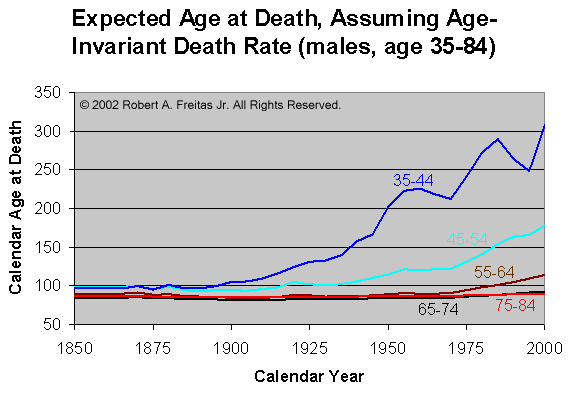
If you're over 45, the picture is not yet so bright. Non-aging biological 50-year-olds would live to a calendar age of 178 years. Non-aging 60-year-olds could only expect to survive to 113 calendar years in the current medical environment. But the news is not all bad for the elders. The death rate for 80-year-old U.S. males fell by 45 percent during the last century. So some progress is definitely being made. The problem is that the absolute natural death rate is still so high among the elderly that the Expected Age at Death has not yet significantly improved.
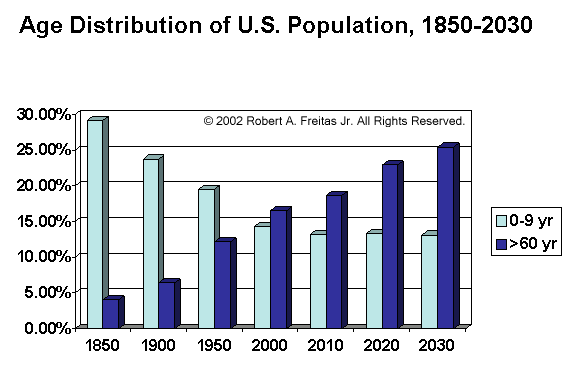
Now, you remember those Expected Age at Death curves for the youngsters that began their steep climb into extended longevity in the late 19th Century? The biggest gains were in the 1-10 year old cohorts, where death rates fell 30- to 60-fold. These gains began at a time when this age cohort made up 20 to 30 percent of the U.S. population. Early deaths in this gigantic demographic bulge were of great concern to medical researchers at the time, who lavished their resources on solving this problem.
I think history is about to repeat, this time at the opposite end of the age scale. In the United States, people over 60 years of age already make up the single largest cohort at 16.5 percent, and this cohort grows to 20 to 30 percent of the U.S. population after 2015, and for decades beyond. As before, this demographic bulge will focus research scientists and research dollars towards solving the problem of premature death among the very old.

And there's another societal motivation to reduce death rates. As nations become more industrialized, their birth rates go down. In the developed world, the birth-to-death ratio has been declining for decades. In many countries, there are already more deaths each year than births, which, in the long run, is a prescription for national extinction. To avoid a Population Implosion, these nations must get busy and reduce their death rates to below their falling birth rates.
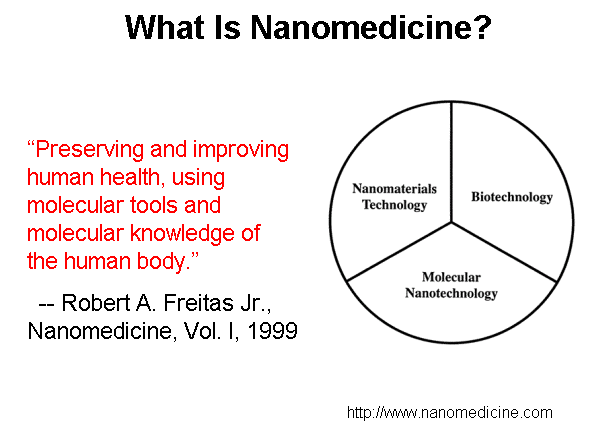
The greatest advances in halting biological aging and preventing natural death are likely to come from the fields of biotechnology and nanotechnology. That is, nanomedicine. Nanomedicine is most simply and generally defined as the preservation and improvement of human health, using molecular tools and molecular knowledge of the human body.
In the near term, say, the next 5 years, the molecular tools of nanomedicine will include biologically active materials with well-defined nanoscale structures, such as dendrimer-based organic devices and pharmaceuticals based on fullerenes and organic nanotubes. We should also see genetic therapies and tissue engineering becoming more common in medical practice.
In the mid-term, the next 5 or 10 years or so, knowledge gained from genomics and proteomics will make possible new treatments tailored to specific individuals, new drugs targeting pathogens whose genomes have now been decoded, stem cell treatments to repair damaged tissue, replace missing function, or slow aging, and biological robots made from bacteria and other motile cells that have had their genomes re-engineered and re-programmed. We could also see artificial organic devices that incorporate biological motors or self-assembled DNA-based structures for a variety of useful medical purposes.
For more information on the way in which we think such devices would work, you can view the original lecture materials. My website contains links to more advanced material, including my technical designs for nanomechanical devices for medicine.
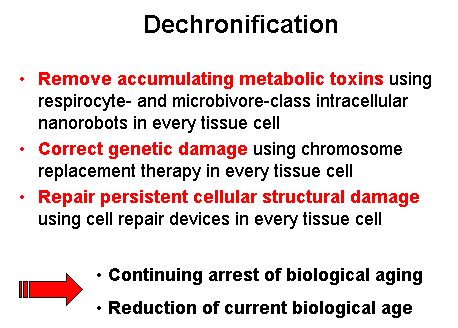
The end result of all these nanomedical advances will be to enable a process I call "dechronification" - or, "rolling back the clock." I see no serious ethical problems with this. According to the volitional normative model of disease that is most appropriate for nanomedicine, if you're physiologically old and don't want to be, then for you, oldness and aging are a disease, and you deserve to be cured. After all, what's the use of living many extra hundreds of years in a body that lacks the youthful appearance and vigor that you desire? Dechronification will first arrest biological aging, then reduce your biological age by performing three kinds of procedures on each one of the 4 trillion tissue cells in your body.
- First, a nanodevice will be sent to enter every tissue cell, to remove accumulating metabolic toxins and undegradable material. Afterwards, these toxins will continue to slowly re-accumulate as they have all your life, so you'll probably need a whole-body cleanout to prevent further aging, maybe once a year.
- Second, chromosome replacement therapy can be used to correct accumulated genetic damage and mutations in every one of your cells. This might also be repeated annually.
- Third, persistent cellular structural damage that the cell cannot repair by itself such as enlarged or disabled mitochondria can be reversed as required, on a cell by cell basis, using cellular repair devices.
We're still a long way from having complete theoretical designs for many of these machines, but they all appear possible in theory, so eventually we will have good designs for them.
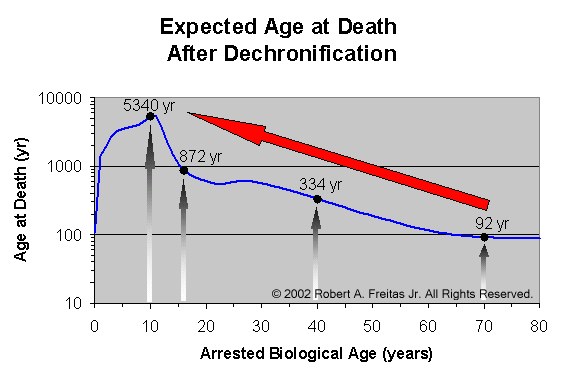
Using these annual checkups and cleanouts, and some occasional major repairs, your biological age could be restored once a year to the more or less constant physiological age that you select. I see little reason not to go for optimal youth - though trying to maintain your body at the ideal physiological age of 10 years old might be difficult and undesirable for other reasons.
A rollback to the physiology of your late teens would be easier to maintain and more fun. That would push your Expected Age at Death up to around 900 calendar years. You might still eventually die of accidental causes, but you'll live ten times longer than you do now.
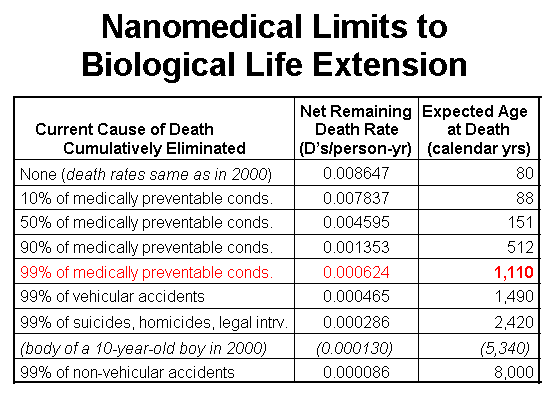
How far can we go with this? Well, if we can eliminate 99 percent of all medically preventable conditions that lead to natural death, your healthy lifespan should increase to about 1100 years. It may be that you'll find it hard to coax more than a millennium or two out of your original biological body, because deaths from suicides and accidents have remained stubbornly high for the last 100 years, falling by only one-third during that time.
However, one can hope that the rate of suicides might be greatly reduced, with so much to look forward to, and with new nanomedical treatments for unhealthy mental states. Nanotechnology can also improve the overall safety of our material environment, leading to far fewer deaths from accidents.
Finally, genetic modifications or nanomedical augmentations to the human body may extend healthy lifespans still further, to a degree that cannot yet be accurately predicted.
In closing, I hope you'll agree with me that natural death is an outrage. Indeed, it is humanity's, and history's, greatest outrage. Now, at long last, maybe we can finally do something about it. So let's get on with it!
Thank you.
For more information about my writings on nanomedicine, please visit the following websites:
People die. It's natural.
Deal with it.
This is crazy abstract thinking . In the actual biology of ageing there are
limits set by genetics. They control the production of telomerase that affect telomeres which determine the length of activity in chromosomes. Every animal has this limitation which is why they all live to diffenrent ages .In culture, human cells can only divide for a limited number of times even under lab conditions of no diseases, no stress and all the food and growth factors necessary to provided for life. The only exceptions are cancer cells which have lost that genetic control . So while you could argue that if you knew how to do that cells would go dividing for ever but applied to a human person you would become one big fat tumor. That's life but not worth living .
this is interesting point of focus.
Many people would be thankful to be able to be unburdened by the stress and strains of day to day living in this age within which we live ,
i wonder what the efffects would be on families were medicine to begin this type of transition over the next ten years at an accelerated rate and provide a family with one treatment of each of its family members with just one of these renewal healing dechronifications.
the cost would be out of the normal persons budget most likely , however it does seem our world might begin a new and vigorous change in values within the family and throughout society in general.
Safe
I dont understand your thinking Maybe it cause im drunk but I was always to believe that human life was A wick that was burned short Please explain to me why If you can with Nano's Preserve Life Then why arnt more doing it ? i dont wanna live past 70 let alone 100 + Explain to me why you think a human life should Go further then its ment to, think you will learn somthing Different then everyone else has
I can agree that a vast amount of information is lost with each person dying which maybe seen as an "outrage" of sorts. But please, death is a natural part of living. From an existentialist/humanistic perspective, death being an inevitability is motivation for living. I'de argue that the suicide rate would increase, if there is no fear of dying, there's no reason to make a life of it! Furthermore, where's the motivation to breed, and will it enable people to breed forever if they are at optimal physical peak all their lives. The exponential growth in the population would be catastrophic!
One of the reasons the worlds population is so high is the advances in medical science. Now imagine if we couldn't die a natural death. The effects of overpopulating the world are an outrage!!! If your nanotechnology can as you say "improve the overall safety of our material environment", can it also be used to rebuild/upgrade the infrastructure around us, regrow crops in bad over farmed soil, restore forests that will likely be destroyed by an ever growing population etc etc. It would be an "outrage" to administer this type of technology among people allowing them to live for thousands of years. I believe in medical progress but the advancement of this type of technology would be disastrous if used in the wrong hands - and the author of this in my opinion = the wrong hands!
One poster above was drunk. And three of the others might as well be.
The comments on this article are honestly infuriating. What is this cheap logic that makes people believe that "death is a natural part of living" or that nature comprises some sort of inherent morality? It should be clear to anyone by this point that nature is absolutely AMORAL; it is infinitely cruel and infinitely wasteful, and there is absolutely nothing 'natural' about it. The total indifference of the natural world towards us is the reason why most of us are so hopelessly befuddled in our search for any kind of meaning in our measly crack of light between two eternities of darkness. We are bound to never know where we came from or where we are headed, always lost and naked under the vastness of an "awful power that neither hates nor loves, but rolls all things together meaninglessly to a common doom."
For those of you who believe that the search for longevity strategies are not worth the effort, great, no-one will force you to make use of them, you are free to age 'gracefully' on your way towards a natural death. For those of us, however, who have come to the conclusion that staking our chances on believing -even for a second- that these technologies might... just *might*... be a plausible way towards the reduction of the useless pain and suffering associated with aging, and that that might benefit all of humanity, I think we deserve a chance at proving ourselves wrong. It's time that people stop using one-valued logic to reach their wrong conclusions. It's been long enough that these truthfully uneducated guesses as to the "possible future uses of this technology" have hindered important research in this field, as was the case with stem-cells.
It's funny that anyone would risk drowning themselves to save a drowning child, but are vehemently against possibly saving the lives of millions of aging people staring death in the face. EVERY life is worth saving without discrimination or hesitation. Please stop this pseudo-ethical discourse! It's harming the development of a truly important field of study!
I'm 30 years old, have a batchers degree and am TERRIFIED of death, natural or otherwise! I know i have a long while to live, that im still young, but the very idea of all my memory, my experience and love just stopping just scares the hell out ta me! I hope to have children one day, which may end up happening late in life, and I want to see them grow up. If I age normally, that may not happen. So, if nanotechnology or anything else can extend my life, I'm all for it!
I agree, lets fight aging. I want to be able to fuck hot 20 year olds in my 90's!
We need to move beyond being satisfied with a pill that gets old dick hard, we should demand people get benefit from their effort.
Such type of writing linked to research leads to destruction of mankind on earth's surface. The author looks in the expanded longevity of a man - a concept against Nature's doctrine. the author has forgotten to suggest about means of sustenance of resultant population numbers particularly in terms of biodiversity. To my opinion such type of research needs to be discouraged.
How curious, I think this is the most fitting area, snugged away in the internet that I leave my message for anyone to read.
The first of it's kind, a digital revolution, the changing of humanity itself. As I continue to research the legitimacy behind what I begin to help. I've realized what I have truly involved myself with, taking part of the first of it's kind.
The internet has become more accurate than any recording of book, more telling than any individuals opinion. All actions and thoughts unless edited by the individual are frozen in time, allowing anyone to review anything. Everyone is frozen in time, with their arguments, their beliefs and fears. There is no reason behind any of it asides the unknown, but it is all visible and shows unbiased how conflict even in needless to be areas can arise.
I wonder if I'm the only one who is searching for the absolute honesty behind the pursuit of anti aging, why Calico exists, why SENS exist. Why has SENS been around for so long while Calico appeared so recently. What is googles purpose in funding something completely different while ignoring what seems to be working. Is Calico's underlying purpose financial?
If anyone here reads this while they themselves curiously look to see the legitimacy of the entire anti aging industry, I can say good luck to you. It's certainly confusing to me.
I believe 3 things guide and mold our future, and they are Tech, Tech, and Tech. I believe gaming and VR are just fads and could turn out to be as addictive as heroin. The first Tech is material science and biological engineering. The second Tech is learning to use the endless supply of building materials in the Solar System. The third Tech will be bending all the technology we can muster to create new lands in outer space by ripping apart asteroids, moons, comets, and planets to support our burgeoning population here on Earth by siphoning off billions of people to live in Stanford Torus’s and McKendree Cylinders. These future ever young teen cyborgs(on the cellular level, no ‘Borg’ look) will have the needed ability to withstand the higher radiation levels of outer space. They will have open ended life spans. Run and not tire. They will never age, but will have the wisdom of centuries of living. NASA published a report in 2005 stating the Solar System could support 10 quadrillion people. There is an endless supply of material between here and half way to the next star system. In the same light as we don't need evolution, and we will take hold of our own genetic destiny, we don't need planets anymore, and we will build human made planets encompassing millions of square miles. Even at 1 quadrillion human-cyborgs those future humans would have 10x's what we have now.
There are 500+ star systems in a 100 light year sphere around the Sun. Let’s say we eventually travel to these stars and finding no intelligent life, we transform the material there into eventual living space for 2 quadrillion people each star. The human population of the Milky Way galaxy would reach 1 quintillion humans. This would not happen over night. It would take a few thousand years. If you have an open ended lifespan, you can go there set up a colony and come back. Sell the movie rights.
The estimated number of stars in our quadrant of the Milky Way is 25 to 100 billion star systems. Using the middle figure(50 billion stars) and cutting that in half(25 billion stars), using a lower figure than the NASA estimate of 10 quadrillion humans for our own star system(because we don’t know the amount nor quality of resources out there), let’s say 500 trillion, I estimate we could be looking at 12.5 septillion human teenage cyborgs in 10,000 to 30,000 years. If we conquer the whole galaxy, you can quadruple that figure.
I know a lot of people will think, why should I care. I understand that thinking. Once you get above a conceivable number, around 10 billion humans, the average mind is boggled. Also because the next 999, 990 billion humans will live off planet, they believe they won’t have much contact with them. Oh, but they will have interaction with you or your descendants. They will be us. Transformed maybe, but they will be us, all the same. Those that choose life on Stanford Torus’s or McKendree Cylinders will have the latest and greatest the human race has to offer, better health, better chance at wealth, and a myriad of other opportunities will be theirs. This will cause a serious brain drain from Earth to the stars. Those that take up the yoke and their progeny will have the highest life style that is possible in a new age. You would want to be there. The alternative is living on a declining Earth in the back waters of a revolution. Think about it.
An actuarial study was, not too long ago, commissioned by http://www.sens.org . The gist of the study concentrated on the outcome of the eradication of diseases, and aging. The findings showed without disease, or aging the average life expectancy would zoom to 5,000 years, with half dying before 5,000 due to accident, war, famine, or suicide, and the other half living much longer. The first person to reach 5,000 years old is alive somewhere on Earth, right now. It could be you! Live, long and prosper!
P.S.: The Sun produces 159 trillion times more energy each year than we currently need to keep civilization going. We won't be running out of energy soon. We have an endless supply of material and energy. The only things we lack are vision, imagination, and the will to act!
Dylan Thomas's Poem, "Do Not Go Gentle Into That Good Night" and his verse, "Rage, rage against the dying of the light" should be on the Heading of all your literature. You have to move the heart that moves the mind that manifests the results you are seeking.
I hope the average life expectancy zooms to 5,000 years in my lifetime